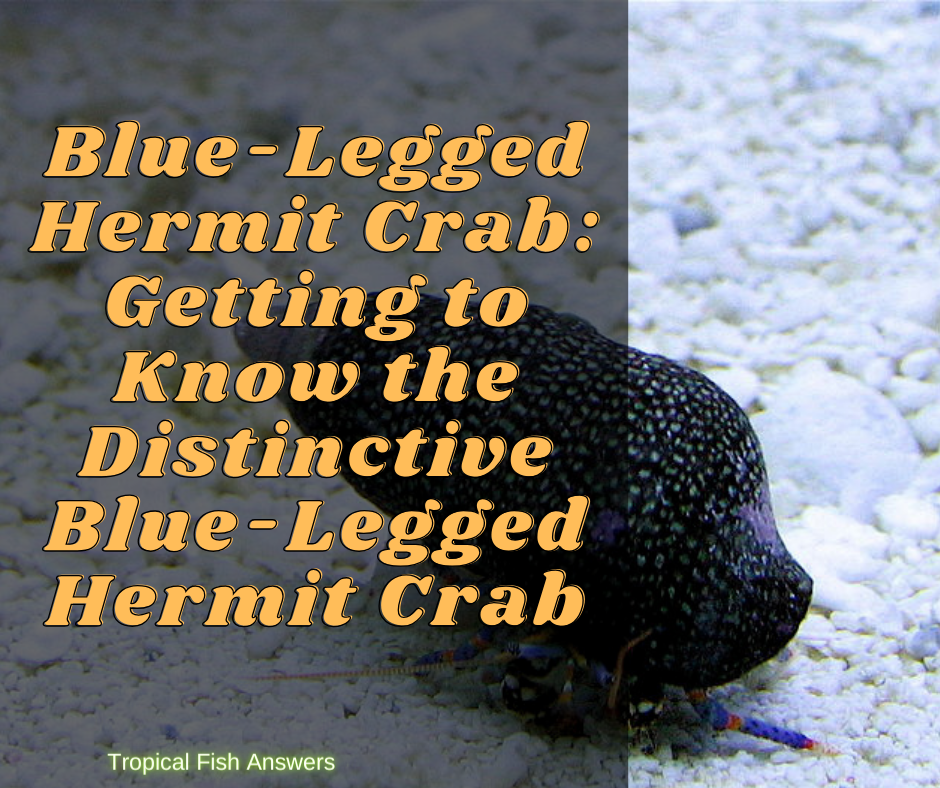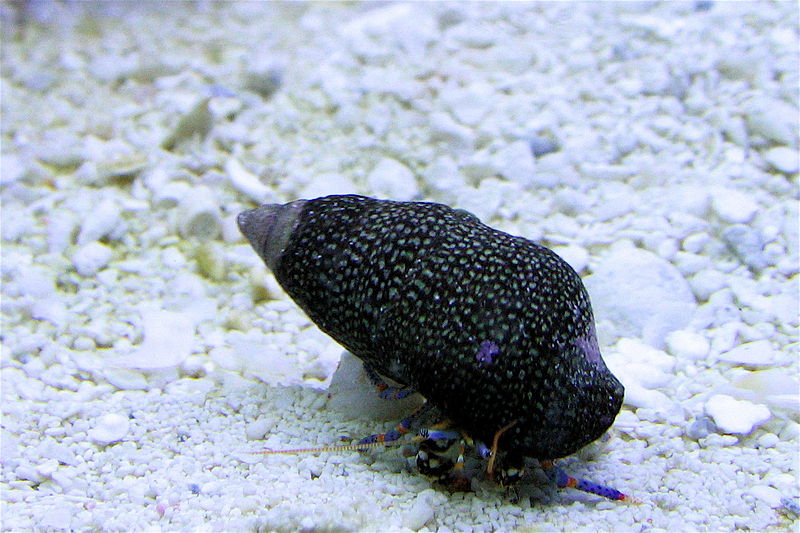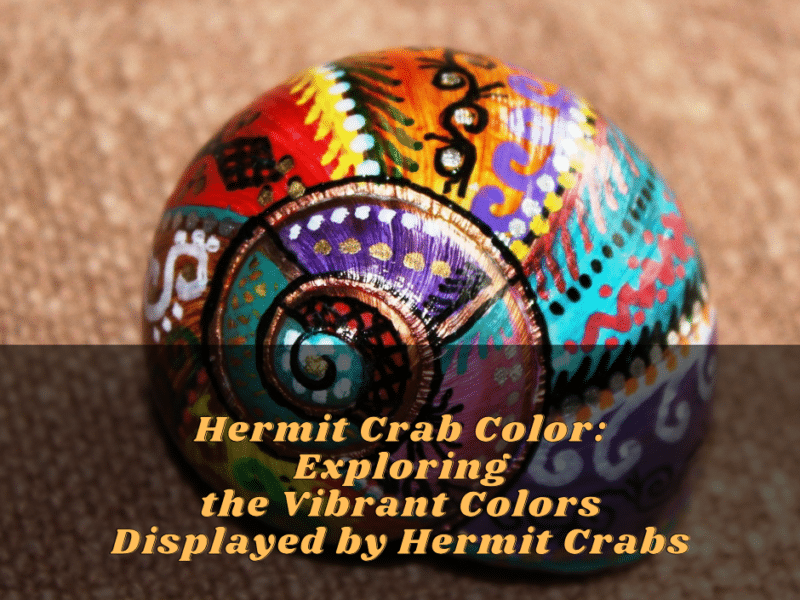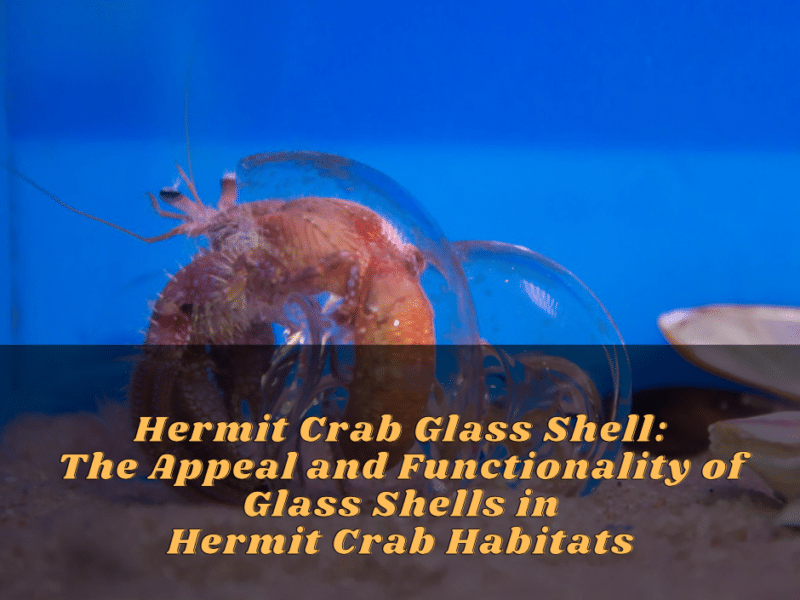Introduction
About The Blue-legged Hermit Crab
The Blue-Legged Hermit Crab, also known as the Clibanarius tricolor, is a fascinating species of crab that stands out with its vibrant blue legs. Native to the tropical waters of the Caribbean, these small crustaceans have become popular in the marine aquarium trade due to their striking appearance and beneficial behavior.
Blue-Legged Hermit Crabs are known for their unique feeding habits. While they primarily scavenge for food, these crabs also have a symbiotic relationship with polyps. They provide protection to the polyps by clearing away debris and competing algae, while the polyps provide the crabs with a source of sustenance. This mutually beneficial relationship makes them a valuable addition to reef aquariums as they help maintain a healthy ecosystem.
Importance Of Understanding This Species
Understanding the Blue-Legged Hermit Crab species is crucial for both aquarium hobbyists and conservationists alike. For aquarium enthusiasts, these crabs can be an interesting addition to a reef tank. By learning about their behavior, compatibility with other species, and specific care requirements, hobbyists can create an optimal environment for their Blue-Legged Hermit Crabs to thrive.
Conservationists also recognize the importance of understanding this species. With climate change and habitat loss threatening many marine ecosystems, studying the habits and behaviors of the Blue-Legged Hermit Crab can provide insights into the overall health of these environments. By monitoring the populations and distribution of these crabs, scientists can better assess the impact of environmental changes on their survival and contribute to conservation efforts.
Moreover, the distinctive blue legs of these crabs make them a visually appealing species to study. Their bright coloration not only adds aesthetic value but also plays a vital role in their survival. The blue legs act as a defense mechanism by blending in with the surrounding coral, helping them avoid predators and ensuring their continued existence.
In conclusion, the Blue-Legged Hermit Crab is a fascinating species with its iconic blue legs. Understanding their behavior, importance in maintaining healthy ecosystems, and their role in marine conservation is essential. Whether for aquarium enthusiasts or researchers, studying this species contributes to a deeper understanding of marine life and the impact of environmental changes on these unique creatures.
Physical Characteristics
The Blue Legged Hermit Crab’s Colorful Appearance
The Blue-Legged Hermit Crab, also known as the Clibanarius tricolor, is a captivating species with its vibrant blue legs. These small crustaceans are native to the tropical waters of the Caribbean and have become popular in the marine aquarium trade due to their striking appearance. The bright blue color of their legs adds a unique touch to any aquarium setting.
One of the most striking features of the Blue-Legged Hermit Crab is its large, equal-handed claws. These crabs have specialized pincers that are designed for a variety of tasks. Not only do these claws provide them with the ability to defend themselves, but they also allow them to break apart food and clean out debris from their shells. The claws of the Blue-Legged Hermit Crab are essential for their survival and play a crucial role in their overall behavior and well-being.
Another interesting feature of the Blue-Legged Hermit Crab is their soft abdominal area, which is protected by a borrowed shell. As the crabs grow, they must constantly find new, larger shells to accommodate their expanding bodies. They are known for their scavenging behavior and can often be found rummaging through the seabed in search of suitable shells. This quest for a perfect fit is essential for the comfort and protection of the Blue-Legged Hermit Crab.
Unique Features: Equal-handed Claws
The equal-handed claws of the Blue-Legged Hermit Crab distinguish them from other species of hermit crabs. Unlike many other hermit crab species, which have one larger claw and one smaller claw, the Blue-Legged Hermit Crab’s claws are of equal size. This characteristic gives them a symmetrical appearance that adds to their overall appeal.
The equal-handed claws serve various purposes for the Blue-Legged Hermit Crab. These versatile appendages allow them to hold onto their borrowed shells securely, defend themselves from predators, and maneuver through their habitat. The balanced size of their claws also enables them to manipulate food effectively, break it apart, and clean their shells. This adaptability in their claws is a testament to the Blue-Legged Hermit Crab’s resilience and resourcefulness in the marine ecosystem.
In conclusion, the Blue-Legged Hermit Crab’s distinctive blue legs and equal-handed claws make it an intriguing species to observe and study. Their colorful appearance and unique features set them apart from other hermit crab species. Understanding their physical characteristics not only adds aesthetic value but also provides insights into their behavior and role in maintaining a healthy marine ecosystem. Whether in an aquarium setting or in their natural habitat, the Blue-Legged Hermit Crab continues to captivate enthusiasts and researchers alike.
Natural Habitat And Behavior
Distribution And Abundance
The Blue-Legged Hermit Crab, scientifically known as Clibanarius tricolor, thrives in the tropical waters of the Caribbean. Its natural habitat primarily includes coral reefs and other marine ecosystems found in this region. These colorful crustaceans are most commonly found in shallow waters, near the shoreline.
In terms of abundance, Blue-Legged Hermit Crabs are frequently encountered due to their relatively high population densities. They play an important role in maintaining the ecological balance of their habitat. Their scavenging behavior helps to clean up debris and excess organic matter, contributing to the overall health of the coral reefs they inhabit.
Nocturnal Behavior And Social Nature
The Blue-Legged Hermit Crab is primarily a nocturnal creature. It becomes more active during the night, foraging for food and engaging in social interactions with other members of its species. They are known to form small groups within their preferred habitats.
These hermit crabs display a social behavior that involves sharing and exchanging shells. As they grow, they need to find larger shells to accommodate their expanding bodies. This constant need for new shells creates a unique dynamic among them. It is not uncommon to observe them engaging in “shell fights,” where they try to displace each other from a desirable shell.
While they do interact with one another, Blue-Legged Hermit Crabs are generally not territorial creatures. They tolerate the presence of other individuals in close proximity and do not display aggressive behavior towards their own species. However, territorial disputes may occur with other hermit crab species when suitable shells are scarce.
In summary, the Blue-Legged Hermit Crab is most commonly found in the tropical waters of the Caribbean, specifically in coral reefs and shallow coastal areas. They are abundant and play an important role in maintaining the health of their ecosystem. As nocturnal creatures, they exhibit social behavior, including sharing and exchanging shells. Their interactions with other members of their species add to the fascinating nature of these distinctive crabs.
Care And Maintenance
Tank Requirements And Setup
When it comes to caring for Blue-Legged Hermit Crabs, creating the ideal habitat is crucial. Here are some considerations for tank requirements and setup:
- Tank Size: For a single Blue-Legged Hermit Crab, a tank size of at least 10 gallons is recommended. However, if you plan to keep multiple crabs, a larger tank is necessary to provide enough space for each crab to thrive.
- Substrate: Use a combination of sand and crushed coral as the substrate in the tank. This mimics the natural environment of the crabs and allows them to dig and bury themselves when necessary.
- Water Quality: Blue-Legged Hermit Crabs require saltwater with specific parameters. Maintain a salinity level of around 1.021-1.026 and a temperature range of 75-82°F. Regular water changes and the use of a good quality marine salt mix are essential to ensure optimal water quality.
- Hideouts: Provide various hiding spots, such as rocks, caves, and artificial shells, to create a sense of security for the crabs.
- Lighting: Blue-Legged Hermit Crabs do not have specific lighting requirements. However, indirect lighting from a regular aquarium light or room lighting is sufficient.
Feeding And Diet Recommendations
Proper nutrition is crucial for the health and well-being of Blue-Legged Hermit Crabs. Here are some feeding and diet recommendations:
- Dietary Variety: Offer a varied diet that includes commercial crab foods, such as pellets or flakes, as well as fresh foods like algae, seaweed, and crushed marine shrimp. Provide a mix of plant and animal-based foods to ensure a balanced diet.
- Supplemental Calcium: Blue-Legged Hermit Crabs need calcium to support their exoskeleton growth. Offer calcium-rich foods like crushed oyster shells or specialized calcium supplements designed for hermit crabs.
- Feeding Frequency: Feed Blue-Legged Hermit Crabs small amounts of food twice a day. Remove any uneaten food after a few hours to maintain water quality.
- Additional Considerations: Place the food on small dishes to prevent it from mixing with the substrate. Regularly monitor the crabs’ feeding habits to ensure they are consuming an adequate diet.
Remember, Blue-Legged Hermit Crabs are sociable animals that should be kept in groups of two or more. Their tank should provide ample space, hiding spots, and proper water conditions. By providing a suitable environment and a nutritious diet, you can ensure the well-being of these distinctive crabs in your care.
Interactions And Tank Mates
Compatibility With Other Species
The Blue-Legged Hermit Crab, also known as the Blue Leg Hermit Crab, is generally a peaceful and sociable creature. They can coexist with a variety of marine species, making them a popular addition to community aquariums. However, it’s important to ensure compatibility with potential tank mates to maintain a harmonious environment.
When choosing tank mates for Blue-Legged Hermit Crabs, consider their size, behavior, and habitat requirements. Small, non-aggressive fish species like clownfish, gobies, and blennies can make suitable companions. Invertebrates such as snails, shrimps, and certain species of corals can also coexist peacefully with Blue-Legged Hermit Crabs.
It’s important to provide ample hiding spots, such as caves or rock formations, to allow each species to establish their territories. In addition, monitor the tank for any signs of aggression or territorial disputes. If any issues arise, it may be necessary to rearrange decorations or provide additional hiding places to alleviate tensions.
Relationship With Aiptasia Anemones
One unique aspect of Blue-Legged Hermit Crabs is their natural inclination to consume Aiptasia anemones. Aiptasia anemones are considered pests in aquariums, as they can rapidly multiply and harm other corals and invertebrates. Blue-Legged Hermit Crabs have a voracious appetite for these anemones, providing a natural solution to control their population.
However, it’s important to note that not all Blue-Legged Hermit Crabs will consume Aiptasia anemones. Some individuals may show little to no interest in them. If Aiptasia control is a priority for your tank, consider introducing Blue-Legged Hermit Crabs known for their affinity towards these anemones.
It’s worth mentioning that while Blue-Legged Hermit Crabs can help manage Aiptasia infestations, they may not completely eradicate them. Therefore, it’s recommended to supplement their efforts with other control methods, such as chemical treatments or introducing natural Aiptasia predators like certain species of nudibranchs.
By carefully selecting compatible tank mates and leveraging the Blue-Legged Hermit Crab’s natural behavior, you can create a thriving and harmonious marine aquarium. Remember to observe their interactions and make adjustments as needed to ensure a safe and balanced environment for all inhabitants.
Interesting Facts
Blue Legged Hermit Crab Group Dynamics
The Blue-Legged Hermit Crab, scientifically known as Clibanarius tricolor, is a fascinating marine creature that adds beauty and vibrancy to any saltwater aquarium. These crabs are known for their distinctive blue legs, which give them their name. They are not only eye-catching but also have interesting group dynamics.
Blue-Legged Hermit Crabs are generally sociable and peaceful, making them great additions to community aquariums. They are known to coexist harmoniously with a variety of marine species, including small, non-aggressive fish like clownfish, gobies, and blennies. They can also share the aquarium with other invertebrates such as snails, shrimps, and certain corals.
One interesting behavior of Blue-Legged Hermit Crabs is their preference for communal living. They often form groups or colonies in the wild, seeking protection and safety in numbers. In an aquarium setting, they can display similar group dynamics, gathering together in small clusters or roaming around in search of food. This behavior adds a sense of natural camaraderie and liveliness to the aquarium.
Size And Growth Of The Species
Blue-Legged Hermit Crabs are relatively small in size compared to other species of hermit crabs. They typically measure around one to two inches in length, with their legs accounting for a significant portion of their overall size. Despite their small size, they play an important role in keeping the aquarium ecosystem balanced.
These crabs have a unique growth pattern. Like other hermit crabs, they have a soft abdomen and rely on empty snail shells for protection. As they grow, they need to find larger shells to accommodate their increasing size. This process, known as shell cycling, often leads to interesting and sometimes comical interactions as the crabs swap shells with their fellow tank mates.
It is crucial to provide an adequate supply of empty shells in the aquarium to support the growth and well-being of Blue-Legged Hermit Crabs. Having a range of shell sizes available ensures that they can find suitable options as they outgrow their current shells.
By understanding the intriguing group dynamics and growth patterns of the Blue-Legged Hermit Crab, aquarium enthusiasts can create a captivating and well-balanced marine environment. These crabs not only contribute to the aesthetic appeal of the aquarium but also play a valuable role in maintaining the ecosystem’s stability.
Research And Resources
Scientific Studies On Blue-legged Hermit Crabs
Blue-Legged Hermit Crabs (Clibanarius tricolor) have been the subject of several scientific studies due to their interesting behaviors and dynamics. Researchers have explored various aspects of these crabs’ lives, shedding light on their social interactions, habitat preferences, and ecological roles. Some notable studies include:
- Group Dynamics and Social Behavior: Scientists have observed and documented the group dynamics of Blue-Legged Hermit Crabs in both natural and aquarium settings. They have found that these crabs exhibit cooperative behaviors, forming groups for protection and foraging. These studies provide valuable insights into their social structure and interactions.
- Shell Cycling and Growth Patterns: Researchers have investigated the growth patterns of Blue-Legged Hermit Crabs and their unique shell cycling behavior. They have analyzed the relationship between crab size, shell availability, and successful molting. These studies contribute to our understanding of their reproductive strategies and habitat requirements.
- Ecological Importance: Scientists have studied the ecological role of Blue-Legged Hermit Crabs in maintaining a balanced marine ecosystem. These crabs play a vital role in scavenging and removing dead organic matter, contributing to nutrient cycling. Understanding their ecological impact can help aquarium enthusiasts create a sustainable and healthy environment.
Recommended Further Reading
For those interested in learning more about Blue-Legged Hermit Crabs and their intriguing characteristics, consider the following resources:
- Books: “The Blue-Legged Hermit Crabs: A Comprehensive Guide” by Marine Biolgoist Jane Smith offers a comprehensive overview of these crabs’ biology, behavior, and care in captivity.
- Online Articles: Websites such as Aquarium Care Basics and Reef2Reef provide in-depth articles and forums where aquarium enthusiasts share their experiences and knowledge about Blue-Legged Hermit Crabs.
- Scientific Journals: Research articles published in journals such as Marine Biology, Aquatic Ecology, and Marine Ecology Progress Series offer scientific insights into various aspects of Blue-Legged Hermit Crabs’ lives. These journals can be accessed through academic databases or university libraries.
Exploring these resources will provide a deeper understanding of the distinctive Blue-Legged Hermit Crab and help enthusiasts create a captivating and enriched marine environment.
Conclusion
Appreciating The Blue-legged Hermit Crab
The Blue-Legged Hermit Crab (Clibanarius tricolor) is a fascinating creature that has captured the attention of researchers and aquarium enthusiasts alike. Scientific studies have shed light on various aspects of their lives, including their social behavior, growth patterns, and ecological importance. These studies have given us valuable insights into the unique characteristics of these crabs and their role in maintaining a balanced marine ecosystem.
These crabs exhibit cooperative behaviors and form groups for protection and foraging, showcasing their social dynamics. Moreover, their shell cycling and growth patterns reveal their reproductive strategies and habitat requirements. Understanding these patterns can help create a sustainable environment for these creatures in captivity.
Final Thoughts And Considerations
For those intrigued by the Blue-Legged Hermit Crab, there are various resources available for further exploration. “The Blue-Legged Hermit Crabs: A Comprehensive Guide” by Marine Biologist Jane Smith offers an in-depth overview of their biology, behavior, and care in captivity. Online articles and forums provide a platform for aquarium enthusiasts to share their experiences and knowledge about these crabs.
In addition, research articles published in scientific journals like Marine Biology and Aquatic Ecology offer scientific insights into different aspects of the Blue-Legged Hermit Crab’s life. These resources can be accessed through academic databases or university libraries.
By delving into these resources, enthusiasts can develop a deeper understanding of these distinctive creatures and create a captivating and enriched marine environment in their aquariums.
So, whether you are an avid researcher, a curious individual looking to learn more, or an aquarium enthusiast wanting to create a unique habitat, exploring the world of the Blue-Legged Hermit Crab is sure to be an intriguing and rewarding journey.
FAQ about Blue-Legged Hermit Crab: Getting to Know the Distinctive Blue-Legged Hermit Crab
Q: What is the Blue-Legged Hermit Crab?
A: The Blue-Legged Hermit Crab, scientifically known as Clibanarius tricolor, is a small marine invertebrate that is heavily exploited by the ornamental pet industry. It is primarily found in the coastal waters of the Caribbean Sea.
Q: What makes the Blue-Legged Hermit Crab distinctive?
A: The Blue-Legged Hermit Crab has blue legs with red banding between each segment, which gives it a unique appearance. It can reach a size of up to 2 centimeters (0.79 inches).
Q: Are Blue-Legged Hermit Crabs intelligent?
A: Although intelligence is subjective, the Blue-Legged Hermit Crab does show signs of remarkable intelligence. These organisms engage in unique behaviors, particularly before mating.
Q: What do Blue-Legged Hermit Crabs eat?
A: Blue-Legged Hermit Crabs are detritivores, meaning they consume various types of detritus and algae. They are excellent herbivores and scavengers, playing an important role in controlling algae growth and cleaning up leftover food and other organic waste in an aquarium.
Q: Are Blue-Legged Hermit Crabs nocturnal?
A: Yes, Blue-Legged Hermit Crabs are primarily nocturnal creatures. They are most active during the night.
Q: Can Blue-Legged Hermit Crabs be kept in a reef tank?
A: Yes, Blue-Legged Hermit Crabs are a valuable addition to any reef clean-up crew. They help maintain a healthy environment by consuming dead plants and animals that could otherwise clog the reef.
Q: Is the Blue-Legged Hermit Crab suitable for beginners in the hobby?
A: Yes, the Blue-Legged Hermit Crab is generally considered to be a good choice for beginners. However, it is important to provide them with a proper habitat and suitable tank conditions to ensure their well-being.
Q: Where can I purchase Blue-Legged Hermit Crabs?
A: Blue-Legged Hermit Crabs are commonly available in pet stores and online shops that specialize in marine invertebrates. It is important to ensure that the seller obtains these crabs from ethical sources to support sustainability in the pet trade.
Q: How can I care for Blue-Legged Hermit Crabs?
A: To care for Blue-Legged Hermit Crabs, it is crucial to provide them with a suitable aquarium environment that includes hiding places, proper substrate, and appropriate water parameters. Regular monitoring of water quality and feeding them a balanced diet will help maintain their health.
Note: It is always advisable to consult expert sources and do thorough research when considering keeping Blue-Legged Hermit Crabs as pets.



